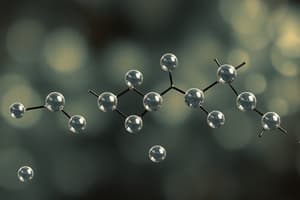Podcast
Questions and Answers
What is the main principle of selective toxicity in chemotherapy?
What is the main principle of selective toxicity in chemotherapy?
- Selectively finding and destroying pathogens without damaging the host (correct)
- Finding and destroying all types of cells in the body
- Killing all microbes, including beneficial ones
- Interfering with the growth of human cells
What is the therapeutic index of a medication?
What is the therapeutic index of a medication?
- The lowest dose of a medication that is effective
- The highest dose of a medication that can be used
- The number of microbes killed by a medication
- The ratio of the lowest dose toxic to a patient to the dose used for therapy (correct)
Why are some medications too toxic for systemic use but used topically?
Why are some medications too toxic for systemic use but used topically?
- They have a narrow spectrum of activity
- They interfere with essential structures or properties common in human cells (correct)
- They are not effective against a wide range of pathogens
- They have a high therapeutic index
What is the mechanism of action of penicillin G?
What is the mechanism of action of penicillin G?
What is the characteristic of antimicrobial medications that allows them to selectively target pathogens?
What is the characteristic of antimicrobial medications that allows them to selectively target pathogens?
What is the term for the use of chemicals to treat a disease?
What is the term for the use of chemicals to treat a disease?
What is the primary mechanism by which Gram-negative bacteria are resistant to most β-lactam antibiotics?
What is the primary mechanism by which Gram-negative bacteria are resistant to most β-lactam antibiotics?
Why is Mycobacterium tuberculosis intrinsically resistant to many antibiotics?
Why is Mycobacterium tuberculosis intrinsically resistant to many antibiotics?
What is the term for microbes that are resistant to large numbers of antibiotics?
What is the term for microbes that are resistant to large numbers of antibiotics?
What is the primary reason for the alarming rise in antimicrobial resistance?
What is the primary reason for the alarming rise in antimicrobial resistance?
What is the name of the bacteria that is intrinsically resistant to antibiotics and has a new name, Clostridioides difficile?
What is the name of the bacteria that is intrinsically resistant to antibiotics and has a new name, Clostridioides difficile?
What is the term for the concentration of antibiotic that inhibits the growth of bacteria?
What is the term for the concentration of antibiotic that inhibits the growth of bacteria?
What is the primary mechanism of antibacterial drugs that target cell wall synthesis?
What is the primary mechanism of antibacterial drugs that target cell wall synthesis?
Which test is used to determine the minimum inhibitory concentration (MIC) of an antibacterial drug?
Which test is used to determine the minimum inhibitory concentration (MIC) of an antibacterial drug?
What is the primary difference between MIC and MBC?
What is the primary difference between MIC and MBC?
What is the purpose of the zone of inhibition in the disk-diffusion method?
What is the purpose of the zone of inhibition in the disk-diffusion method?
What is the advantage of the E-test over the disk-diffusion method?
What is the advantage of the E-test over the disk-diffusion method?
What is the significance of selective toxicity in antibacterial therapy?
What is the significance of selective toxicity in antibacterial therapy?
Flashcards are hidden until you start studying




